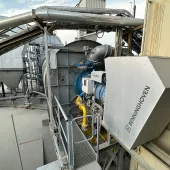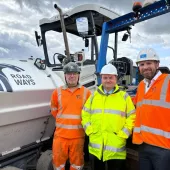Asphalt surfacing success for London Gateway port and logistics hub

First published in the April 2014 issue of Quarry Management as London’s new Gateway
Good co-operation, communication and collaboration by Nynas, Hanson and Toppesfield ensures surfacing success at Britain’s new global shipping port
Britain’s new global shipping port on the north bank of the river Thames, east of London, welcomed its first vessel, the MOL Caledon, on 7 November 2013. Operated by DP World, London Gateway port and logistics hub has been under development for more than 10 years across 777ha (three square miles) of brownfield land, and the opening of its first berth was a major milestone.
Planning considerations meant one key element of civils work was left almost to the last moment, however, with this having to be completed quickly and also with the utmost care. Access to the port and its allied distribution centre required carriageways of asphalt to last a minimum of a decade without maintenance, despite the heaviest of use. The possibility of wheel track deformation was not an option.
Main contractors for the still ongoing £6.8 million ‘Port access road and bridge’ contract is VolkerFitzpatrick; asphalt subcontractors were Toppesfield Ltd; with Hanson delivering their proprietary Tufflex and Tuffpave asphalt products. The Tufflex was bound by high-performance Endura Z2 polymer-modified bitumen from binder specialists Nynas Bitumen UK.
‘The job has been a demanding one in terms of the time frame, the need for pavement durability and longevity, plus the poor bearing capacity of the ground,’ said VolkerFitzpatrick’s project manager, Nick Horner. The site, upon which originally stood an oil refinery, is overlain with a metre of made-up material under which lies 12m of alluvial substrate underlain by 12–15m of shale.
Sub-base for the port and distribution access roads was created before VolkerFitzpatrick arrived on site and preloaded to promote as much of the 120mm expected settlement as possible before construction began. ‘There was a requirement that the carriageway pavements themselves should be able to accommodate a degree of movement plus be very hard-wearing and maintenance free for 10 years,’ said Mr Horner.
Containerized cargo to be shifted from the port berths to the distribution centre will not just be heavy, but of necessity carried on slow-moving vehicles, the most onerous type of loading with respect to wheel tracking of flexible (ie asphalt) pavement. ‘The asphalt mixes chosen had to display extraordinary characteristics,’ said Mr Horner. ‘Hanson made the best proposal and it is their products which have gone into the roads.’
The road sections are not particularly long. Each is less than 1km and linked by a substantial roundabout, representing around 19,000m2 of surface area in total. ‘Nevertheless, they represented quite a challenge in asphalt terms, especially given the condition of the sub-grade,’ commented Hanson’s UK technical manager, Adrian Hadley. ‘The base and binder layers had to display workability, early strength and fatigue resistance, plus provide a high softening point to produce a very heavy-duty asphalt with a high resistance to deformation.’
Hanson proposed the use their Tufflex proprietary asphalt for the lower layers using Nynas Endura Z2 binder, and following detailed discussions this was accepted. ‘Endura Z2 is a very special, highly polymer-modified hot-mix binder,’ said Nynas asphalt engineering support manager Jukka Laitinen.
‘It is one of our ‘Premium’ products that has been specially developed to deliver the optimum balance between toughness and flexibility, and is suitable for the most onerous asphalt paving applications. It is second to none in producing pavements that are durable, rut resistant and which require minimum interventions.’
Asphalting specialists Toppesfield were chosen to supply and lay the material not just because of their quality and price, but also their proactive approach to achieving good results, not least overall completion to time, according to VolkerFitzpatrick’s Nick Horner. ‘As a delivery team, we were all up against it. We (VolkerFitzpatrick) won our design-and-build contract (for both the roads and a railway overbridge) in January last year with everything to be in a useable state by the end of October,’ he said.
‘On the road sub-grades, we had to wait until July for sufficient settlement to have taken place for earthworks to begin. We couldn’t hand over to Toppesfield until August, giving them little time to do their work. This meant the pressure was on Toppesfield, their asphalt supplier Hanson, and Hanson’s supplier Nynas.’
‘We had one week from award of contract to start of work, beginning on site on 27 August,’ said Toppesfield’s operations director, Craig Germeney. ‘Security was very tight; all our site personnel and delivery drivers had to have a security induction to gain access to the port.’ The window was a tight one – everyone knew when the first ship was due in. ‘All of us, Toppesfield, Hanson and Nynas, had to be right first time in terms of quality and delivery. Mistakes were to be avoided at all cost.’
Pavement layer data is as follows: basecourse190mm thick Tufflex XD, 20mm aggregate, 8,500 tonnes in total; binder course 60mm thick Tufflex, 14mm aggregate, 3,000 tonnes in total; and surface course 40mm thick Tuffpave, 10mm aggregate, 1,800 tonnes in total. There were no noticeable hiccups in supply or laying. One Toppesfield laying gang worked virtually solidly for 24 shifts to get the job finished.
‘I’d say the project has been a good one,’ said Mr Horner (a second phase has also gone well, to extend the port access road to reach the A1014 Manorway and via this the M25. This section of access road carries relatively lighter loads and is made with traditional materials). ‘The three ‘Cs’ have prevailed, with co-operation, communication and collaboration all being good between the delivery teams, which was essential to prevent us tripping over one another. The surfacing is defect free and, best of all, the client has actually mentioned in favourable terms the quality of the work.’
London Gateway
London Gateway is Britain’s first 21st century deep-sea container port and Europe’s largest logistics park, providing infrastructure suitable for the next generation of ULCS (ultra-large container ships), ie vessels up to 400m in length with the capacity to carry 18,000+ containers. Owners and operators DP World claim London Gateway will provide unrivalled deep-sea shipping access to the largest consumer markets in the UK. Superior operational systems and service will ensure ships load and unload as fast as possible. Linked to the national rail network, London Gateway will reduce transport costs for exporters and importers, and trucking miles for supply chains. The port’s distribution centre will allow state-of-the-art reception and onward delivery of imported goods.
- Subscribe to Quarry Management, the monthly journal for the mineral products industry, to read articles before they appear on Agg-Net






